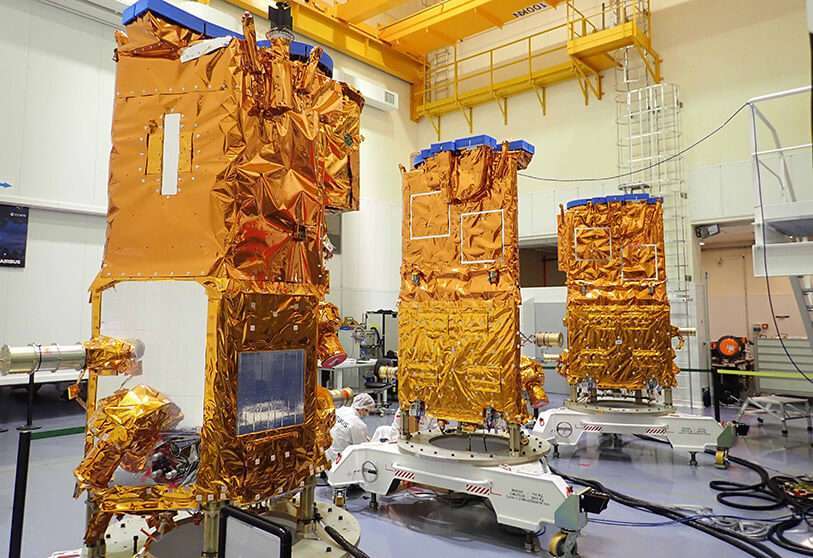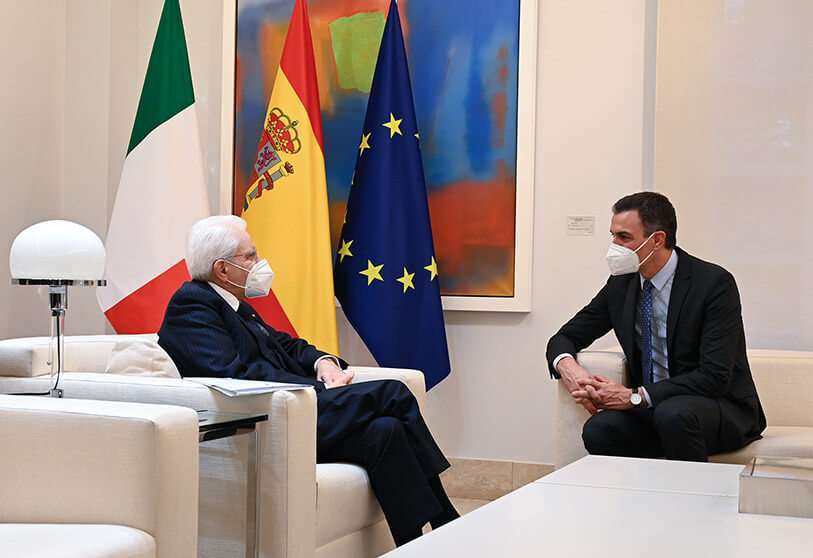France puts three electronic ears in orbit to pick up encrypted communications and radar signals

It was not one, not two, but three spy satellites that France has just successfully launched into orbit, much to the delight of the President of the Republic, Emmanuel Macron. They all flew into position in space inside an Italian-made Vega launcher, which was fired from the Kourou space base in French Guiana, northern Brazil.
The take-off took place on Tuesday, 16 November, at 10:27 Spanish peninsular time, shortly before King Felipe VI and Queen Letizia officially welcomed the President of Italy, Sergio Mattarella, on his first visit to Spain, at the Royal Palace in Madrid.

It happened when the Minister of Defence, Margarita Robles, was in the middle of a meeting in Brussels with her counterparts from the European Union to discuss European missions beyond the EU's borders. Among the attendees was Florence Parly, the French head of the military portfolio, whom the Spanish minister will presumably have congratulated on the success of the mission.
The French authorities are aware that space is an important arena in which sovereignty must be firmly established. And this is what they say, regardless of their political leanings. Florence Parly is unequivocal that CERES - as the constellation of three spy satellites is called - is an "innovative instrument for France's sovereignty and strategic independence", while at the same time contributing to "strengthening our space defence capabilities".
And no wonder. CERES is the first signals intelligence or SIGINT (SIGnal INTelligence) satellite constellation developed by a European Union nation. The major powers, the United States, Russia and China, have a wide range of SIGINT platforms, some specialising in communications intelligence (COMINT) and others in electronic intelligence (ELINT) to detect ballistic missiles, provide early warning of incursions by air or sea and conduct communications eavesdropping.

Aware that it cannot keep up technologically with Washington, Moscow or Beijing, Paris' geostrategic ambitions have led its leaders to find a compromise solution at a cost of 450 million euros. Its three SIGINT devices embark sensors dedicated to collecting data travelling through space. They can detect, locate and characterise electromagnetic signals from radar over a wide range of frequencies, analyse telecommunications traffic and interpret the encryption of sensitive information that could affect the security or economy of the Hexagon.
With CERES, Macron hopes that a fiasco on the scale of the cancellation of the contract with Australia for 12 submarines and its scrapping of the trilateral AUKUS agreement will not happen again. The full name of the network is Capacité de Renseignement Electromagnétique Spatiale (CERES - Capacity for Electromagnetic Space Intelligence), a fancy name for the Roman goddess of fertility. Obviously, everything important about these satellites is stamped with the seal of military secrecy.

However, as they are located in low Earth orbit, it is not difficult to know that they are at an altitude of between 670 and 700 kilometres. From the Vega launcher's payload manifest, it is also known that they are small micro-satellites, weighing just under 450 kilos each and with a single solar panel to power the on-board equipment. The three fly in a triangular formation, but separated from each other by a fixed distance that is kept secret, but is estimated to be several hundred metres or a few kilometres.
Thanks to their arrangement around our planet, they are able to fly with impunity over all areas of the world and collect signals and data from areas of operations and scenarios that are inaccessible to ground-based, maritime or airborne sensors. The CERES architecture thus becomes a key instrument for providing the Paris government with intelligence that results in greater autonomy in its decision-making.
It will provide French military commanders with a more detailed knowledge of the capabilities and intentions of their adversaries, as well as a better assessment of the tactical, operational and strategic situation in the Theatres of Operations where their units are deployed abroad. Once they enter service within the next few weeks, CERES will be listening with their electronic ears around the globe 24 hours a day.

The three satellites work together and are positioned in space to cover almost the entire globe. From their various orbital positions, when a radar on the ground, on board an aircraft or a ship anywhere in the world emits electromagnetic signals or pulses, each of them detects it, but at a slightly different instant in the microsecond range.
From that instant, sophisticated algorithms perform triangulation operations on the information collected by each satellite and compare it with the time delay of signal reception. This makes it possible to geolocate the exact position of the transmitter and to obtain the data that determine the characteristics of the transmitting radars or the place from which the telecommunications are propagated. Eavesdropping operators and signal and network analysts contribute to this.

The CERES programme has been developed within the framework of the Directorate General for Armaments (DGA), whose head is the general armaments engineer Jöel Barre, who was in Madrid at the beginning of November to visit the Spanish International Defence and Security Fair, FEINDEF 2021. Spain has yet to join the CSO programme for high-resolution electro-optical spy satellites, but it has not been invited to join CERES, which is far from being an out-of-the-blue initiative.
CERES is the consequence of technological and operational lessons learned decades ago. From four 120-kilogram ELISA electronic intelligence demonstrator micro-satellites launched in December 2011. They were preceded in December 2004 by four other communications intelligence satellites named ESSAIM, also weighing 120 kilos each. Earlier, the tiny Cerise and Clementine - launched in July 1995 and December 1999, respectively - both weighing only 50 kilos and manufactured by the then Alcatel Espace on the basis of a design by the British company Surrey, had been tested.

As is standard practice at the French defence ministry, the design and development work to make the CERES constellation a reality has been shared between the French branches of Airbus Defence & Space and Thales Alenia Space, whose contracts date back to 2015. Airbus Defence & Space was responsible for manufacturing and integrating the three micro-satellites at its Toulouse factory. Thales provided the critical technology and detection sensors, as well as the automatic decryption equipment and software applications to enable analysts on the ground to extract intelligence from the seemingly harmless noises swarming through space.











